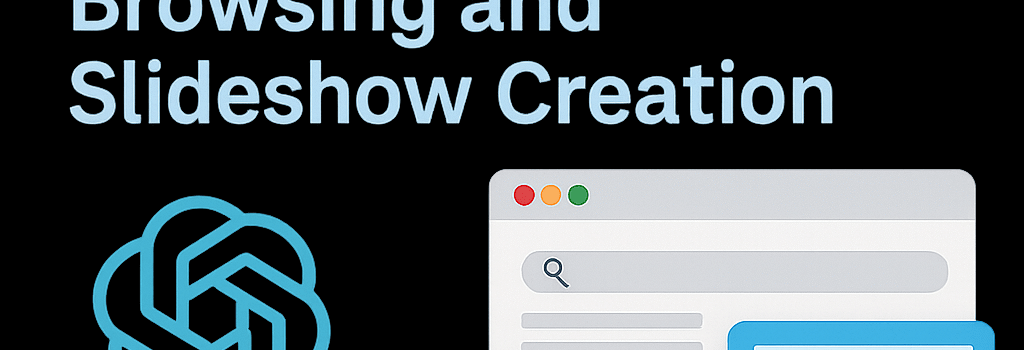ChatGPT Agent: Exploring Autonomous Browsing and Slideshow Creation

Overview
On July 17, 2025, OpenAI launched ChatGPT Agent, its most advanced “agentic AI” to date. Building on prior tools like Operator and Deep Research, the new agent can autonomously navigate the web, execute code in a sandboxed environment, and generate complex deliverables such as PowerPoint slide decks. Since launch, OpenAI has rolled out enterprise connectors for Salesforce and expanded third-party plugin support, with voice-activated and mobile WebView capabilities arriving in late 2025.
Agent Architecture
- Core Model: GPT-4o with 1.8 trillion parameters, fine-tuned for tool use
- Sandbox Environment: Firecracker microVMs orchestrated via Kubernetes on Azure and AWS
- Tool Access: Virtual browser (Chromium headless), POSIX-like terminal, LibreOffice/PowerPoint COM automation
- Connectors API v2.1: Secure integrations with Gmail, GitHub, Salesforce, Zapier, and custom REST endpoints
- Latency: ~200 ms per API call, Redis-backed caching for repeated queries
Integration Architecture
ChatGPT Agent uses a modular plugin framework. Each Connector runs as an independent service, communicating with the agent via gRPC streams over mTLS. Requests are orchestrated by an internal Orchestrator component, which tracks task state, manages retries, and merges multimodal reasoning outputs (text, code, HTTP responses).
Performance Benchmarks Deep Dive
OpenAI reports state-of-the-art results, though independent verification is pending:
- Humanity’s Last Exam: 41.6% accuracy (vs. GPT-4o without tools at 24.9%)
- FrontierMath: 27.4% with Python tool access (vs. 19.3%)
- DSBench: 89.9% data analysis, 85.5% data modeling (vs. 64.1%/65.0% for humans)
- BrowseComp: 68.9% retrieving hard-to-locate web data
- SpreadsheetBench: 45.5% accuracy in spreadsheet edits
“Performance in benchmarks is promising, but real-world chaining of novel steps remains challenging,” notes Dr. Emily Chen, senior researcher at AMD AI Labs. “The agent excels when tasks align with its training data but struggles with entirely new workflows.”
Real-world Use Cases and Expert Opinions
- Automated Presentation Generation: Users supply a topic and branding assets; the agent produces slide decks via Office COM control, with layout guided by an ML-driven template engine.
- E-commerce Workflows: Assembling outfits, comparing prices, and auto-purchasing through Shopify and Stripe connectors.
- Data Pipeline Updates: Fetching online financial reports, updating connected Google Sheets or Excel files, and emailing summaries.
“ChatGPT Agent represents a major step toward practical autonomous assistants,” says Andrej Karpathy, ex-Tesla AI director. “Its microVM sandboxing and end-to-end tool orchestration set a new bar for safety and flexibility.”
Security and Privacy Considerations
The multi-component design introduces novel risks:
- Prompt Injection: Malicious hidden fields on web pages may attempt to hijack control flows. OpenAI’s defenses include adversarial training and user-confirmation gates for high-risk actions.
- Data Exposure: All browsing occurs on OpenAI servers; local user data remains isolated. Users can delete browsing logs and active sessions with one click.
- Regulatory Compliance: EEA and Swiss deployments are pending GDPR attestation; enterprise customers benefit from SOC 2 Type II and ISO 27001 certifications.
Future Roadmap
OpenAI plans to:
- Open-source a lightweight agent runtime for on-premise deployments.
- Integrate vector-database search for richer long-term memory.
- Enhance layout polish in PowerPoint generation with CSS-style theming engines.
Conclusion
ChatGPT Agent pushes the envelope of agentic AI, marrying a massive language model with a secure, sandboxed execution environment. While current capabilities shine in routine web workflows and document creation, complex, novel tasks remain a frontier. As third-party audits and real-world trials emerge, we’ll better understand its reliability and safety in production settings.